Abstract
Cultivation has been identified as an essential stage for biofuel production. This research has examined two important parameters for the industrial production of microalgae, namely microalgae growth rate and biomass productivity. Chlorella vulgaris and Scenedesmus quadricauda were cultivated using a closed photobioreactor (PBR). A novel approach for cultivation and energy input reduction was developed by incorporating periods of darkness during cultivation, as would happen in nature. Three different LED light sources (white, red, and green) were used to determine the conditions that result in the highest growth rate and biomass productivity. C. vulgaris and S. quadricauda responded differently to lighting conditions. It was found that, depending on the LED source and light period, different growth rates and biomass productivities were obtained. Overall, experimental results obtained in this study indicated that a white LED is more effective than green or red LEDs in increasing microalgae growth rate and biomass productivity. A maximum growth rate of 3.41 d−1 and a biomass productivity of 2.369 g L−1d−1 were achieved for S. quadricauda under a 19 h period of white light alternating with 5 h of darkness. For C. vulgaris the maximum growth rate of 3.49 d−1 and maximum biomass productivity of 2.438 g L−1d−1 were achieved by continuous white light with no darkness period.
1. Introduction
Due to the rapid depletion of fossil fuels and the climate change caused by their use, several natural energy sources such as wind [1], solar [2], and biomass [3,4] have been studied, but these are still limited by the natural environment. According to IEA 2019 reports entitled “tracking transport”, bioenergy is currently the only multifunction form of renewable energy that can directly produce electricity as well as fuels used in transportation. Biomass energy is derived from plants; it is considered both a clean energy source [5,6] and a sustainable one [7]. It is sustainable because microalgae biomass does not damage or deplete natural resources. It supports long-term environmental balance; hence, it has been proposed as a potential alternative to petroleum and can provide clean and renewable energy [8]. Microalgae are unicellular organisms with complex and robust cell walls. Among their advantages are the oil yields higher than oil seeds and food crops such as jatropha or corn. Microalga culture does not require pesticides. Residual biomass of microalgae can be used as fertiliser or livestock feed [9]. It does not compete with food crops for arable land, and it is possible to use municipal wastewater as a source of carbon and nutrients to promote growth [10]. In addition, according to the IEA 2019 report “tracking transport”, microalgae can be grown on land not suitable for agriculture, thus reducing or eliminating the cost of acquiring land. The high availability of microalgae means that fully commercialised technologies could open the door to significant volumes of advanced biofuels for the transport sector, providing diesel substitutes in sectors that are hard to electrify [11]. Microalgae also have the ability to produce intracellular storage compounds: mainly protein (i.e., 50% to 60%), carbohydrates (10% to 20%), and lipids (20% to 30%).
Lipids are oil-producing materials which represent the carbon and energy reserves in a microalga cell. Lipids include two types: neutral lipids that serve as energy reserves and polar lipids that are constituents of organelles and membranes. Microalgal cells accumulate and store neutral lipids in the form of triacylglycerols (TAGs) [11]. TAG content is the key factor in making biodiesel from microalgae, since the associated fatty acids react with methanol to produce fatty acid methyl esters (FAME)—a reaction known as transesterification. As well as being a feedstock for biodiesel, algal fatty acids are of value as a food supplement [12]. For example, long-chain polyunsaturated fatty acids (PUFAs) are confirmed to be especially beneficial to the human diet, including the essential omega-3 fatty acids [13].
Substantial amounts of TAGs can be accumulated in certain microalgae species such as Chlorella and Spirulina, both of which are rich in two of the main types of omega-3 fatty acid—eicosapentaenoic acid (EPA) and docosahexaenoic acid (DHA). As such, these species are cultivated for their high oil content [12,14]. It is easy to increase the amount of lipids in algae by manipulating their temperature, exposure to light, and access to nitrogen. This then ensures the high lipid concentrations that give optimum production of biodiesel [15], bioethanol, pyrolysis oil, refuse-derived fuel (RDF), biogas [16], and other advanced biofuels, all of which are mainly used in transportation [17], electricity, and heat [18]. These contribute to a sustainable quality of life which is well-reported as the basic driver for providing clean, safe, reliable, and secure energy supplies around the globe, as advanced biofuels are a fast-track solution for reducing transport emissions. Microalgae-sourced renewable biofuels such as biodiesel, biogas, bioethanol, and biohydrogen offer solutions for green transport without requiring costly investment in new cars or fuel distribution systems, especially for biodiesel. The combination of CO2 fixation [19,20], biofuel production, and wastewater treatment, as well as the production of high value end products such as human and bull meal, pharmaceuticals, and cosmetics makes microalgae very promising for use in industrial processes [21].
Techniques for biofuel productions from microalgae are microalgae oil to biodiesel [15], anaerobic digestion to biomethane [22], and photobiological conversion to biohydrogen. Despite the promise of fuel production from microalgae, there are limitations in terms of their cultivation which will prevent them from completely replacing fossil fuels for the time being [23]. For some species such as Scenedesmus vacuolatus, the optimum growing conditions were achieved at a light intensity and CO2 concentration below the natural levels; given artificial systems such as a twin layer porous substrate photobioreactor are a significant advantage [24].
Light intensity is the most important parameter that affects microalgae growth and biomass productivity. The term light intensity is used to describe the strength or amount of light produced by a specific light source. Hence, an important consideration to enhance the feasibility of scaling microalgae production from laboratory to pilot and then to industry scale would be adequate light distribution and control that translates into high growth rates and enhanced biomass productivity. This study addresses the effect of different light wavelengths and photoperiods (light/dark cycles) on the growth rate and biomass productivity of two microalgae species: C. vulgaris and S. quadricauda. C. vulgaris is a unicellular microalga with spherical shape and 1 to 6 µm diameter; it is of interest as it is reported to have short doubling time and high biomass productivity. It can produce high amounts of lipids which are converted to biodiesel. S. quadricauda is also a good candidate for biodiesel production as it contains a high percentage of lipids; mainly fatty acids of carbon chain length C14–C18 [25].
2. Materials and Methods
2.1. Microalgae Source and Cultivation Medium
In this study, experiments were performed with microalgae C. vulgaris and S. quadricauda.
These microalgae species were obtained from University of Texas (UT) at Austin and Sciento Manchester, respectively. They were cultivated for 16 days. Biomass was cultivated in a sterilised BG 11 medium with the following composition: sodium nitrate NaNO3 17.6 mM; dipotassium phosphate K2HPO4 0.23 mM; magnesium sulphate MgSO4·7H2O 0.3 mM; calcium chloride, dihydrate CaCl2·2H2O 0.24 mM; citric acid·H2O 0.031 mm; ferric ammonium citrate 0.021 mM; EDTA disodium dihydrate Na2EDTA·2H2O 0.0027 mM; sodium carbonate, Na2CO3 0.19 mM. The cultures were cultivated at pH 7.0 (cultivation took place at pH 7.0 because algae strains thrive at neutral pH) and at 25 °C (ambient temperature was used as it is the normal laboratory/room temperature for experiment).
2.2. Photobioreactor Setup and Operation
The two microalgae samples were cultivated in laboratory scale PBR as shown in Figure 1 with a 2 litres maximum capacity and 137 mm diameter. The PBR is designed to ensure efficient light penetration to produce rapid and robust growth of algae cultures.
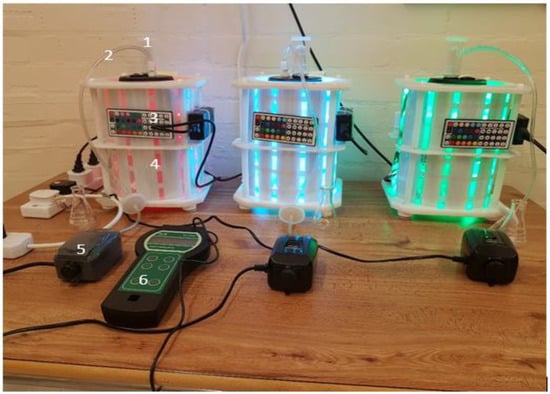
Figure 1.
Closed PBR used in this research. (1) Tube head; (2) CO2 tube; (3) LED lighting remote; (4) PBR outer cover; (5) pump for mixing; (6) handheld photometer.
This photobioreactor configuration has superior performance, for example, when compared to flasks, traditional light sources, and open ponds with respect to controlling culture environment, preventing contamination, good mixing, and increased light utilisation. Better values for all of these parameters are achievable for closed reactors, which translates to higher algae productivity.
The LED lighting platform consists of LEDs with different light wavelengths. For this study, red (620 to 700 nm), white (400 to 700 nm), and green (494 to 577 nm) were chosen to optimise the light source for the microalgae. The gas exchange agitator further enhances growth and is likewise customisable and testable. The cultivation was carried out and maintained in different patterns over a 24 h cycle, each shown as the number of hours of light (L) followed by number of hours of darkness (D). The three different photoperiods of 24L:0D, 19L:5D, and 12L:12D, each carried out with white, red, and green LED wavelengths, gave a total of nine patterns.
2.3. Cell Concentration and Productivity
Growth was monitored every 24 h (Figure 2) by checking absorbance at 680 nm using an Evolution 220 Thermo Scientific USA visible density spectrophotometer. Cultures were taken in three replicates and the average value was recorded.
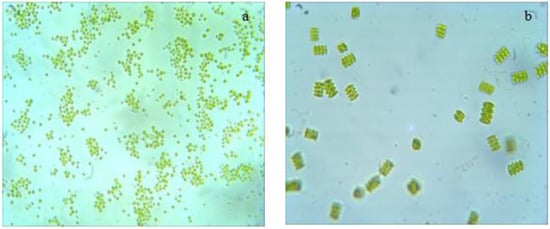
Figure 2.
Microalgae species: (a) C. vulgaris; (b) S. quadricauda.
Three 10 mL samples were taken every day at the same time (circa 10 a.m.) for 16 days where optical density (OD) readings were taken. Insight 2 software was used to perform the absorbance analysis. The obtained values were used to construct growth curves.
Specific growth rate and biomass productivity were calculated using:
where μ is the specific growth rate (d−1), Qx is the biomass productivity (g L−1 d−1), X0 is the initial biomass concentration, X is the final biomass concentration, t is time (d).
Cell concentration was measured by haemocytometry. The haemocytometer by Fisher Scientific, U.S. is composed of nine equally sized large squares. The central one is divided into 25 small squares, each one with a volume of 4 × 10−6 mL. C. vulgaris and S. quadricauda were counted in the small squares since their effective diameters are less than 10 μm. The cell concentration was calculated. The concentrations after 13 days of cultivation for C. vulgaris and S. quadricauda suspensions were 7.6 ± 1.8 × 106 cells mL−1 and 15.8 ± 0.9 × 106 cells mL−1, respectively.
3. Results and Discussion
3.1. Effects of White, Red, and Green Wavelengths and Duration Results on Growth Rate
The growth rate for cultures was calculated under white, red, and green light exposures. It was observed that C. vulgaris achieved the highest growth rate under 24L:0D photoperiod with white light. C. vulgaris growth curves remained almost in the linear range for the whole 24L:0D experimentations under white and especially red light. Under various light sources at constant light (24L:0D) the variation trends of the microalgae growth rate values were similar throughout the experiments, as shown in Figure 3.
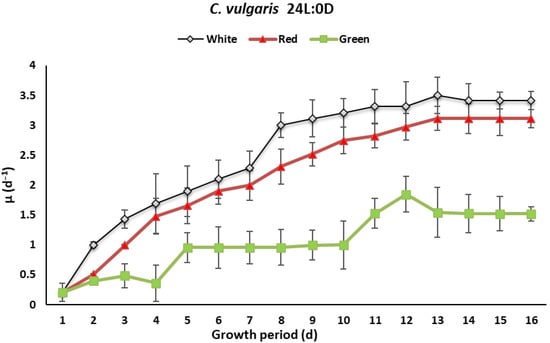
Figure 3.
C. vulgaris growth curves under different lights at 24L:0D.
The present results are 41% higher than those reported by Maroneze et al. [26] for the highest growth rate of Tetraselmis sp. under blue light. Comparative analysis is shown in Table 1. The same pattern was observed by Maroneze et al. [26] when they cultivated Scenedesmus obliquus under white light; it was reported that higher growth rate of 2.51 µd−1 was achieved and Chen et al. [27] reported 1.26 µd−1 for C. vulgaris under blue light wavelength.

Table 1.
Comparison of specific growth rate with other species.
Additionally, the green light resulted in lowest growth rate for both species in all photoperiods compared to white and red lights as shown in Figure 4 and Figure 5 respectively for C. vulgaris and S. quadricauda. In all lighting periods under 24 h C. vulgaris had the highest growth rate.
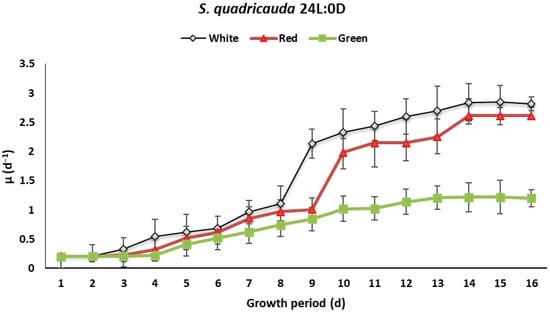
Figure 4.
S. quadricauda growth curves under 24L:0D.
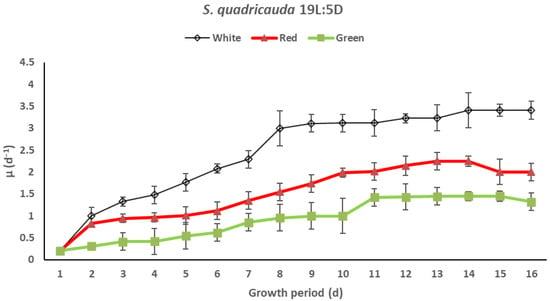
Figure 5.
S. quadricauda growth curves under 19L:5D.
Regarding growth under white light, the average growth rates were respectively 2.390 d−1 and 1.409 d−1 for C. vulgaris and S. quadricauda under 24L:0D. For red light it was 2.023 µd−1 and 1.148 d−1 C. vulgaris and S. quadricauda under 24L:0D. For green light, the average growth rates were 0.456 d−1 and 0.725 d−1 photoperiod. Results proved that both species maintained a steady growth rate under white and red light compared to much slower growth under green light.
In addition, it was observed that S. quadricauda recorded slightly higher growth under green light when compared to C. vulgaris under green light. This was perhaps due to the ability of S. quadricauda to grow with stored energy.
During 19L:5D, it was however observed that S. quadricauda recorded the highest growth rate of 3.41 d−1 on day 14 (Figure 5) compared to a growth rate at 24L:0D light period with value of 2.84 d−1 on day 14 as shown in Figure 5 above. Both curves illustrate the specific growth rate for S. quadricauda under all lights for 24L:0D and 19L:5D light duration (Figure 4). Furthermore, it was observed that growth rate remained constant on days 15 and 16 as represented in the curves in Figure 5.
In 19D:5D, C. vulgaris’ highest growth was observed on days 14 and 15 (Figure 6). Furthermore, it was observed that growth rate remained constant on days 14, 15, and 16 as represented in the plots in Figure 3. However, it was found that the difference on growth rate between both species under red light wavelength was not statistically significant.
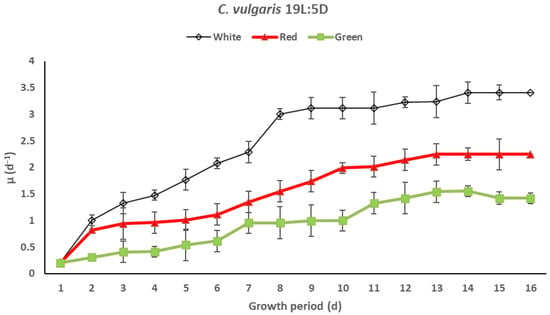
Figure 6.
C. vulgaris growth curves under 19L:5D.
During a 12L:12D photoperiod, under white light, C. vulgaris growth rate increased. Growth rate increased from day 2 to day 11. The highest specific growth rate was observed on day 11 with a value of 1.99 d−1 as shown in Figure 7. From day 12 to day 16 growth rate declined as the species reached death phase. C. vulgaris cultures subjected to 12L:12D under red light had a growth rate of 1.354 d−1 on day 9.

Figure 7.
C. vulgaris growth curves under 12L:12D.
The growth rates under red light for S. quadricauda were 1.305, 1.452, and 0.521 d−1, while growth rates for C. vulgaris were recorded as 2.023, 1.451, and 0.900 d−1 (Figure 8), under 24:0, 19:5, and 12L:12D photoperiods, respectively. Additionally, it was observed that the average growth rate of S. quadricauda under 19L:5D 1.452 d−1 was slightly higher compared to 24L:0D 1.305 d−1. S. quadricauda also recorded slightly higher growth rate under 19L:5D photoperiod compared to C. vulgaris. In the light limiting pattern, cell growth rate decreased with the biomass productivity.

Figure 8.
S. quadricauda growth curves under 12L:12D.
A different scenario was observed under green light as the average specific growth was the lowest for both species in all light durations compared with white and red lights. Both species recorded 0.978 d−1 and 0.685 d−1 for C. vulgaris and S. quadricauda under a 24L:0D photoperiod. Green light was not absorbed but reflected by the cell pigments. A similar pattern was reported by Cetin et al. [28], who determined the growth of C. vulgaris under green light and found that algal growth rate under green light was low.
Additionally, it was reported by Niizawa et al. [29] that the emission profile of green LEDs largely coincides with the “green window” of the visible radiation spectrum explaining the low value observed in all cultures. From these results, consequently, it can be concluded that the microalgae species had a low average growth rate under green light during all photoperiods. This could be that microalgae do not require green light as it has green chlorophyll that reflects it, unlike colour attracts effective growth rate. Therefore, the best suitable light for effective cultivation and biomass productivity is white light.
3.2. Light Wavelength and Duration Results on Biomass Productivity
The biomass productivities were divided into nine patterns, the same as the specific growth rate. In pattern 1, under white light (24L:0D) C. vulgaris and S. quadricauda obtained the biomass productivity rate corresponding to 2.438 g L−1d−1 and 1.559 g L−1d−1, since constant light supply had deeper light penetration thus higher photosynthetic activity in the microalgae culture; this is in line with Yan et al. [30]. In pattern 2, under white light (19L:5D) high biomass productivity was also observed. The average biomass productivity of C. vulgaris and S. quadricauda respectively correspond to 2.421 g L−1d−1 and 2.369 g L−1d−1. In pattern 3, (12L:12D) 1.482 g L−1 and 1.242 g L−1 were achieved at 16 days of cultivation.
In pattern 4, red light was used at 24L:0D, giving 2.112 g L−1d−1 and 1.305 g L−1d−1 for C. vulgaris and S. quadricauda. In pattern 5, under 19L:5D, the key finding was that S. quadricauda had the same biomass productivity as C. vulgaris as shown in Figure 9 where results at different conditions (i.e., light wavelength and durations) are presented. In pattern 6, 12L:12D was used giving 0.820 g L−1d−1 and 0.521 g L−1d−1 for C. vulgaris and S. quadricauda. It has been reported that red light allows higher biomass production by increasing the tolerance to high radiation in cultures. Different microalgae species respond differently to light conditions perhaps due to the presence and activity of different types of photoreceptors [31].
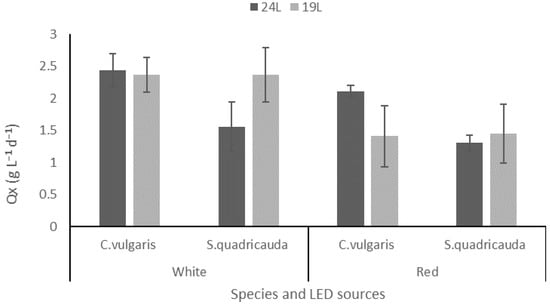
Figure 9.
Biomass productivity.
In pattern 7, green light was used, and biomass productivity was observed as 1.007 g L−1d−1 and 0.725 g L−1d−1 for C. vulgaris and S. quadricauda during 24L:0D light period. During pattern 8 experiments, 0.909 g L−1d−1 and 0.892 g L−1d−1 for C. vulgaris and S. quadricauda was recorded. In pattern 9, biomass productivity yield of 0.427 g L−1d−1 and 0.228 g L−1d−1 was recorded. Overall, dwindling biomass productivity was observed for cultivation under green light. This is correlated with culture growth rate; as already mentioned, green LEDs emit three times fewer photons than other lights. Furthermore, it was observed that in all 12L:12D photoperiods that light limitation resulted in decreased biomass productivity in addition to growth rate. From this study, it was observed that white and red light stimulates higher growth rate and biomass productivity for both C. vulgaris and S. quadricauda. The highest biomass productivity was observed for white LED light. Additionally, it was found that S. quadricauda had slightly higher biomass productivity under 19L:5D compared to C. vulgaris because S. quadricauda can thrive under short periods of darkness. Some species benefited from darkness periods given their photosynthetic cycles, where very fast photic reactions are followed by slower thermochemical reactions.
Biomass productivity of C. vulgaris cultivated under white light in all photoperiods was higher than S. quadricauda. C. vulgaris and S. quadricauda were cultivated under three different photoperiods (24L:0, 19L:5D, 12L;12D) and under three different LED lights (white, red, and green) to determine the conditions that gave the highest species growth rate and biomass productivity. Under various light sources at constant light 24 h the variation trends of the biomass productivity values were similar throughout the experiments. They were both maintained at an almost consistent rate. When the biomass productivity increases, duplication time reduces; this was observed for both species, but the reverse was observed for low biomass productivity—with low biomass productivity duplication time increases. From this study, it can be concluded and further supported that light is essential for biomass productivity and is directly related to microalgae growth rate [32].
C. vulgaris cultures under a photoperiod of 24L:0D with white, red, and green lights obtained the highest biomass productivity. The reverse was observed during the dark cycle cultivation. A consequence of long dark periods is that basic carbon compounds, which have been synthesised in the light, will be respired. This results in reduction of the overall growth rate and biomass yield [26].
In addition, it is evident that optimum light wavelengths and photoperiods for maximised biomass productivity vary for different microalgae. Biomass productivity can be controlled by different light sources. S. quadricauda achieved growth rate and biomass productivity under 19L:5D for red LED as 1.451 d−1 and 1.452 gL−1 d−1, respectively; this is slightly higher for white under same experimental conditions. Consequently, it can be concluded that S. quadricauda thrived the most for growing patterns including short periods of darkness, while C. vulgaris achieved both highest growing rates and biomass productivities for growth under continuous light.
3.3. Implications of LED on Cost, Biomass Productivity on Transport Biofuels, and Way Forward
LEDs are great for their energy efficiency, robustness, long lifetime, and environmental benefits. The ability to adjust LED brightness and colour wavelength in this study was not for cosmetic reasons but, as shown from our results, they reflected how each species responded to each light wavelength. Although LEDs have high initial cost, they have a longer life span than filament or other traditional light sources, thus making the cost over time for LEDs lower than for traditional lighting. For example, LEDs consume less power than a traditional light source to do the same job. This translates to real energy savings, as well as reduced carbon emissions and a positive impact on the environment. Including periods of darkness then further enhances energy saving.
Cultivation efficiency will play a significant role in the steady growth for biodiesel production as algal biodiesel use can improve air quality, reduce atmospheric carbon dioxide concentrations, and decrease engine maintenance [33]. Biodiesel fuel is easily blended with petroleum diesel to make a premium fuel with improved performance [34].
Furthermore, mandatory blending requirements is an essential factor that would lead to the increased consumption and production of biofuels now and in the future. Similarly, a preferential tax system which subsidises biofuel prices from the contribution of state oil fund from conventional fuels to lower the consumer price of biofuel will also increase customer preference [35]. Improved regulation is required to prevent spread of price spikes [36]; this could be done by increasing the price of conventional fuels while reducing biodiesel fuel prices to encourage usage.
Overall, while considering the implications for biofuel production in OECD countries, and increasingly in non-OECD countries, it is evident that biofuels are more environmentally friendly. As a result, adequate cultivation that improves lipid abundance and lowers production cost, along with efficient dewatering techniques with higher drying efficiency, are keys to enhanced commercial production of biofuels for transport applications.
4. Conclusions
This experimental study assessed the effect of using laboratory-scale closed PBRs to efficiently cultivate C. vulgaris and S. quadricauda. Both species were cultivated at three different light periods (24L:0D, 19L:5D, 12L;12D) using three different LED lights sources (white, red, and green) to determine the conditions resulting in the highest growth rate and biomass productivity. S. quadricauda and C. vulgaris responded differently to lighting conditions. It was found that, depending on LED source and light period, different growth rates and biomass productivity were obtained.
Additionally, the key findings were under light intensity of 200 μmol m−2 s−1, high growth rate and biomass productivity for C. vulgaris under white light at 24L:0D was observed, due to a faster growth rate induced by a continuous light intensity. Regarding, S. quadricauda, slightly higher growth rate and biomass productivity was observed under 19L:5D for red light, hence, S. quadricauda thrived the most during dark cycles. Growth rate for both species under green light wavelength for all durations was generally low.
Based on the results obtained, the following conclusions can be drawn:
- White LED light resulted in the highest growth rate and highest biomass productivity. The best light colours for the species studied by order of enhanced productivity are white and red lights. For photoperiod the best order is 24L:0D and 19L:5D for C. vulgaris and S. quadricauda, respectively,
- Green LED light and a long dark period (i.e., 12L:12D) did not show an impressive positive trend in either growth rate or biomass productivity for both microalgae species compared to white and red LEDs and 24L:0D and 19L:5D light durations. It can be concluded that longer dark periods were detrimental to the species mainly under green LED light. Therefore, it is concluded that microalgae have a very short life cycle in the dark under green LED light, and exposure to green wavelength apparently led to slow growth, which would have led stagnation if continued.
- C. vulgaris had shorter duplication time compared to S. quadricauda.
- S. quadricauda thrived the most with a 5 h dark cycle.
- Short periods of darkness (5 h) could be a new strategy to improve biomass productivity under specific light (red). Therefore, under the experimental conditions, the best approach to cultivate both species for enhanced biomass production with short period of darkness was 19L:5D. For commercial process, 5 h of darkness would translate to energy saving over time, when compared to running a 24 h light source. Furthermore, there is not much difference comparing white and red light.
Author Contributions
Conceptualization, R.C.A. and A.G.O.; methodology, R.C.A., C.R. and A.G.O.; software, R.C.A.; validation, R.C.A., C.R., A.D. and A.G.O.; investigation, R.C.A.; writing—original draft preparation, R.C.A., C.R. and A.D. writing—review and editing, R.C.A., C.R., A.D. and A.G.O. All authors have read and agreed to the published version of the manuscript.
Funding
This research received no external funding.
Institutional Review Board Statement
Not applicable.
Informed Consent Statement
Not applicable.
Data Availability Statement
Not applicable.
Conflicts of Interest
The authors declare no conflict of interest.
References
- Ohunakin, O.S.; Adaramola, M.S.; Oyewola, O.M. Wind Energy Evaluation for Electricity Generation Using WECS in Seven Selected Locations in Nigeria. Appl. Energy 2011, 88, 3197–3206. [Google Scholar] [CrossRef]
- Ohunakin, O.S.; Adaramola, M.S.; Oyewola, O.M.; Fagbenle, R.O. Solar Energy Applications and Development in Nigeria: Drivers and Barriers. Renew. Sustain. Energy Rev. 2014, 32, 294–301. [Google Scholar] [CrossRef]
- Rodriguez, C.; Alaswad, A.; El-Hassan, Z.; Olabi, A.G. Improvement of Methane Production from P. canaliculata through Mechanical Pretreatment. Renew. Energy 2018, 119, 73–78. [Google Scholar] [CrossRef]
- Rodriguez, C.; Alaswad, A.; El-Hassan, Z.; Olabi, A.G. Mechanical Pretreatment of Waste Paper for Biogas Production. Waste Manag. 2017, 68, 157–164. [Google Scholar] [CrossRef] [PubMed]
- Huang, Y.-T.; Lai, C.-W.; Wu, B.-W.; Lin, K.-S.; Wu, J.C.S.; Hossain, M.S.A.; Yamauchi, Y.; Wu, K.C.-W. Advances in Bioconversion of Microalgae with High Biomass and Lipid Productivity. J. Taiwan Inst. Chem. Eng. 2017, 79, 37–42. [Google Scholar] [CrossRef]
- Russell, C.; Rodriguez, C.; Yaseen, M. High-Value Biochemical Products & Applications of Freshwater Eukaryotic Microalgae. Sci. Total Environ. 2022, 809, 151111. [Google Scholar] [CrossRef]
- Olabi, A.G. 100% Sustainable Energy. Energy 2014, 77, 1–5. [Google Scholar] [CrossRef]
- Anyanwu, R.C.; Rodriguez, C.; Durrant, A.; Olabi, A.G. Optimisation of Tray Drier Microalgae Dewatering Techniques Using Response Surface Methodology. Energies 2018, 11, 2327. [Google Scholar] [CrossRef]
- Shahi, T.; Beheshti, B.; Zenouzi, A.; Almasi, M. Bio-Oil Production from Residual Biomass of Microalgae after Lipid Extraction: The Case of Dunaliella sp. Biocatal. Agric. Biotechnol. 2020, 23, 101494. [Google Scholar] [CrossRef]
- Collotta, M.; Champagne, P.; Mabee, W.; Tomasoni, G.; Leite, G.B.; Busi, L.; Alberti, M. Comparative LCA of Flocculation for the Harvesting of Microalgae for Biofuels Production. Procedia CIRP 2017, 61, 756–760. [Google Scholar] [CrossRef]
- Zhu, L.D.; Li, Z.H.; Hiltunen, E. Strategies for Lipid Production Improvement in Microalgae as a Biodiesel Feedstock. BioMed Res. Int. 2016, 2016, 7–9. [Google Scholar] [CrossRef] [PubMed]
- Anyanwu, R.C.; Rodriguez, C.; Durrant, A.; Olabi, A.G. Microalgae Cultivation Technologies. Encycl. Smart Mater. 2018, 2, 709–731. [Google Scholar] [CrossRef]
- Hadley, K.B.; Bauer, J.; Milgram, N.W. The Oil-Rich Alga Schizochytrium sp. as a Dietary Source of Docosahexaenoic Acid Improves Shape Discrimination Learning Associated with Visual Processing in a Canine Model of Senescence. Prostaglandins Leukot. Essent. Fat. Acids 2017, 118, 10–18. [Google Scholar] [CrossRef] [PubMed][Green Version]
- Makkar, H.P.S.; Tran, G.; Heuzé, V.; Giger-Reverdin, S.; Lessire, M.; Lebas, F.; Ankers, P. Seaweeds for Livestock Diets: A Review. Anim. Feed. Sci. Technol. 2016, 212, 1–17. [Google Scholar] [CrossRef]
- Onumaegbu, C.; Alaswad, A.; Rodriguez, C.; Olabi, A. Optimization of Pre-Treatment Process Parameters to Generate Biodiesel from Microalga. Energies 2018, 11, 806. [Google Scholar] [CrossRef]
- Rodriguez, C.; Alaswad, A.; Benyounis, K.Y.; Olabi, A.G. Pretreatment Techniques Used in Biogas Production from Grass. Renew. Sustain. Energy Rev. 2017, 68, 1193–1204. [Google Scholar] [CrossRef]
- Wilberforce, T.; El-Hassan, Z.; Khatib, F.N.; Al Makky, A.; Baroutaji, A.; Carton, J.G.; Olabi, A.G. Developments of Electric Cars and Fuel Cell Hydrogen Electric Cars. Int. J. Hydrog. Energy 2017, 42, 25695–25734. [Google Scholar] [CrossRef]
- OECD; IEA; FAO. Technology Roadmap: How2Guide for Bioenergy Roadmap—Development and Implementation; OECD: Paris, France; IEA: Paris, France; FAO: Rome, Italy, 2017. [Google Scholar]
- Kaewkannetra, P.; Enmak, P.; Chiu, T. The Effect of CO2 and Salinity on the Cultivation of Scenedesmus Obliquus for Biodiesel Production. Biotechnol. Bioprocess Eng. 2012, 17, 591–597. [Google Scholar] [CrossRef]
- Tang, D.; Han, W.; Li, P.; Miao, X.; Zhong, J. CO2 Biofixation and Fatty Acid Composition of Scenedesmus Obliquus and Chlorella Pyrenoidosa in Response to Different CO2 Levels. Bioresour. Technol. 2011, 102, 3071–3076. [Google Scholar] [CrossRef]
- Anyanwu, R.C.; Rodriguez, C.; Durrant, A.; Olabi, A.G. Micro-Macroalgae Properties and Applications. Ref. Modul. Mater. Sci. Mater. Eng. 2018. [Google Scholar] [CrossRef]
- Rodriguez, C.; Alaswad, A.; El-Hassan, Z.; Olabi, A.G. Waste Paper and Macroalgae Co-Digestion Effect on Methane Production. Energy 2018, 154, 119–125. [Google Scholar] [CrossRef]
- Dutta, K.; Daverey, A.; Lin, J.G. Evolution Retrospective for Alternative Fuels: First to Fourth Generation. Renew. Energy 2014, 69, 114–122. [Google Scholar] [CrossRef]
- Allegra Carbone, D.; Olivieri, G.; Pollio, A.; Melkonian, M. Growth and Biomass Productivity of Scenedesmus Vacuolatus on a Twin Layer System and a Comparison with Other Types of Cultivations. Appl. Microbiol. Biotechnol. 2017, 101, 8321–8329. [Google Scholar] [CrossRef] [PubMed]
- Onumaegbu, C.; Alaswad, A.; Rodriguez, C.; Olabi, A. Modelling and Optimization of Wet Microalgae Scenedesmus Quadricauda Lipid Extraction Using Microwave Pre-Treatment Method and Response Surface Methodology. Renew. Energy 2019, 132, 1323–1331. [Google Scholar] [CrossRef]
- Maroneze, M.M.; Siqueira, S.F.; Vendruscolo, R.G.; Wagner, R.; de Menezes, C.R.; Zepka, L.Q.; Jacob-Lopes, E. The Role of Photoperiods on Photobioreactors—A Potential Strategy to Reduce Costs. Bioresour. Technol. 2016, 219, 493–499. [Google Scholar] [CrossRef]
- Chen, C.Y.; Yeh, K.L.; Chang, H.Y.; Chang, J.S. Strategies to Improve Oil/Lipid Production of Microalgae in Outdoor Cultivation Using Vertical Tubular-T Ype Photobioreactors. Energy Procedia 2014, 61, 2755–2758. [Google Scholar] [CrossRef]
- Baidya, A.; Akter, T.; Islam, M.R.; Shah, A.; Hossain, M.A.; Salam, M.A.; Paul, S.I. Effect of different wavelengths of LED light on the growth, chlorophyll, β-carotene content and proximate composition of Chlorella ellipsoidea. Heliyon 2021, 7, e08525. [Google Scholar] [CrossRef] [PubMed]
- Niizawa, I.; Leonardi, R.J.; Irazoqui, H.A.; Heinrich, J.M. Light Wavelength Distribution Effects on the Growth Rate of Scenedesmus Quadricauda. Biochem. Eng. J. 2017, 126, 126–134. [Google Scholar] [CrossRef]
- Yan, C.; Muñoz, R.; Zhu, L.; Wang, Y. The Effects of Various LED (Light Emitting Diode) Lighting Strategies on Simultaneous Biogas Upgrading and Biogas Slurry Nutrient Reduction by Using of Microalgae Chlorella sp. Energy 2016, 106, 554–561. [Google Scholar] [CrossRef]
- Chiarini, A.; Quadrio, M. The Light/Dark Cycle of Microalgae in a Thin-Layer Photobioreactor. J. Appl. Phycol. 2021, 33, 183–195. [Google Scholar] [CrossRef]
- Santos, K.R.; Mariano, A.B. Determination of Optimal Algae Concentration for Continuous Growth of Scenedesmus sp. in CHU and Modified CHU Media. Rev. Eng. Térmica 2014, 13, 52–58. [Google Scholar] [CrossRef]
- Charles, M.B.; Ryan, R.; Ryan, N.; Oloruntoba, R. Public Policy and Biofuels: The Way Forward? Energy Policy 2007, 35, 5737–5746. [Google Scholar] [CrossRef]
- Gallagher, B.J. The Economics of Producing Biodiesel from Algae. Renew. Energy 2011, 36, 158–162. [Google Scholar] [CrossRef]
- Rawat, I.; Ranjith Kumar, R.; Mutanda, T.; Bux, F. Biodiesel from Microalgae: A Critical Evaluation from Laboratory to Large Scale Production. Appl. Energy 2013, 103, 444–467. [Google Scholar] [CrossRef]
- Foley, A.; Olabi, A.G. Renewable Energy Technology Developments, Trends and Policy Implications That Can Underpin the Drive for Global Climate Change. Renew. Sustain. Energy Rev. 2017, 68, 1112–1114. [Google Scholar] [CrossRef]
Publisher’s Note: MDPI stays neutral with regard to jurisdictional claims in published maps and institutional affiliations. |
© 2022 by the authors. Licensee MDPI, Basel, Switzerland. This article is an open access article distributed under the terms and conditions of the Creative Commons Attribution (CC BY) license (https://creativecommons.org/licenses/by/4.0/).